Interview
In a Barbie World
On shame, empowerment, and why the clothes are as important as the dolls themselves.
Introduction
"It’s not unlike writing poems. You wait for, want the next one and then it comes, you write it and then it’s on to waiting for, wanting the next." David Trinidad talks with Richard Siken about his fascination with the world of Barbie and the process of creating a collection of his very own.
David Trinidad's most recent book of poems is The Late Show. He is also author, collaborator, or editor on several other volumes, including Plasticville, Phoebe 2002 (with Jeffery Conway and Lynn Crosbie), and Saints of Hysteria: A Half-Century of Collaborative American Poetry (with Denise Duhamel and Maureen Seaton). He lives in Chicago.
Richard Siken: What do you collect?
David Trinidad: My whole adult life I’ve collected books and movies—I’m a sort of a DVD addict. I don’t think of those, though, as real collections. For certain authors I love, I’ll buy different editions of the same books—not to read, but as objects. In that regard I think of book collecting as real collecting. But I have more formal collections. The biggest ones are vintage Barbies and Yardley makeup from the ’60s. Yardley made a line of makeup for teenage girls that was very Mod—their lip gloss was called Slicker and their eye shadow was called Glimmerick, and the packaging had lots of colorful stripes and curlicues. I also have some minor collections: comic books; troll dolls; a line of dollhouse furniture, also from the ’60s, called Petite Princess; board games; Liddle Kiddles, which were these small dolls produced by Mattel; toy theaters; and movie memorabilia, particularly Valley of the Dolls.
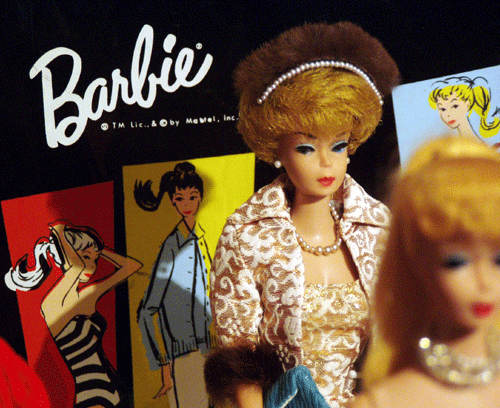
Why Barbie?
It was something that I wanted as a child and couldn’t have. The times and my father forbade it. I have two younger sisters, and they had a pretty abundant Barbie collection. I was a boy and wasn’t supposed to be interested in such things. I was supposed to like war, cowboys, Indians, and Erector sets. I’ve written poems about all this. One’s called, simply enough, “Playing with Dolls.” It’s about sneaking downstairs to look at my sisters’ dolls and how forbidden that was. I’m attached to the dolls and clothing of that period—roughly, between 1959 and 1966. The clothes are important, if not more important, than the dolls. I really like to collect outfits in their original packaging—“never removed from box” or “NRFB,” as they say in collecting circles. It’s a way of possessing the items in the condition they would have been in if I’d been able to purchase them myself at the time. I’m not interested in the garish Barbies they make nowadays.
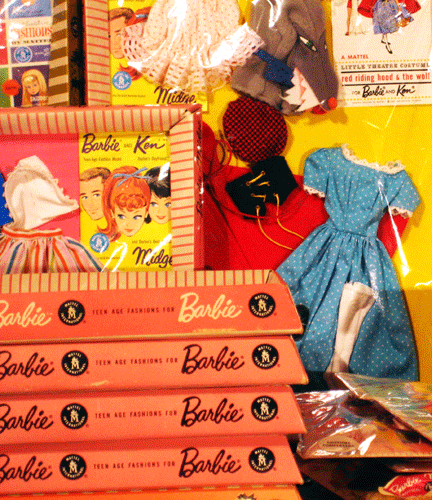
Why Barbie and not Ken?
I collect Ken too. There’s a whole line of characters—friends and relatives of Barbie—that Mattel produced. There’s Ken, Barbie’s boyfriend, and Midge, her best friend, and Skipper, her little sister, and Ken’s friend Allan, and Scooter, who was Skipper’s friend, and Francie, Barbie’s Mod cousin. A whole little universe.
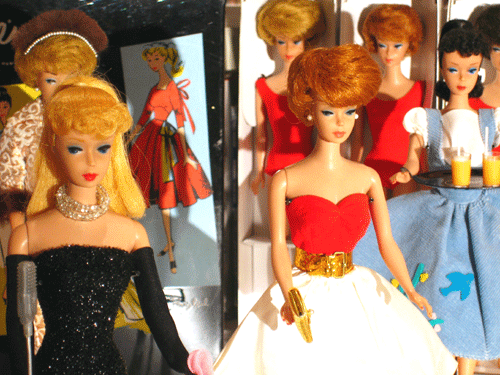
How do you display your collections?
I haven’t displayed them in many years. At the moment, they’re in the closet. In New York, I displayed them in several display cases along a wall, which I dismantled a long time ago. At one point, I thought I was done with collecting and sold off a chunk of my collection. Then after 9/11 and moving from New York to Chicago, I started buying again. Lately I’ve been thinking I might want to display them, but I don’t have the space. This stuff is not supposed to be exposed to direct sunlight, which degrades and fades it. Having a separate room with blacked-out windows would be ideal. I dream of having a separate toy or collection room, a kind of Fortress of Solitude, but have yet to realize that.
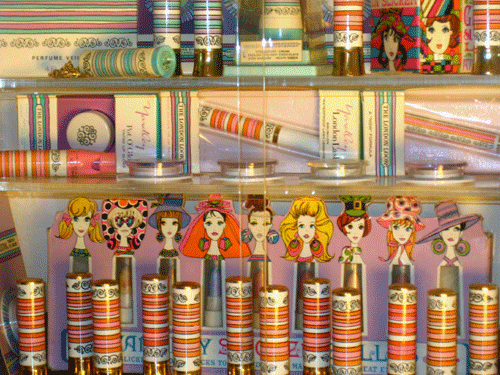
What’s the most important item in your collections?
It isn’t a Barbie product; it isn’t any of the mass-produced things. Those you can sell and buy back later if you want. I have an edition of All My Pretty Ones, which is my favorite Anne Sexton book, signed by her. I have an original Travilla sketch for one of the costumes in Valley of the Dolls. I have three little dresses that my mother made for my sisters’ Barbies. These personalized, one-of-a-kind things are more meaningful to me than the mass-produced items.
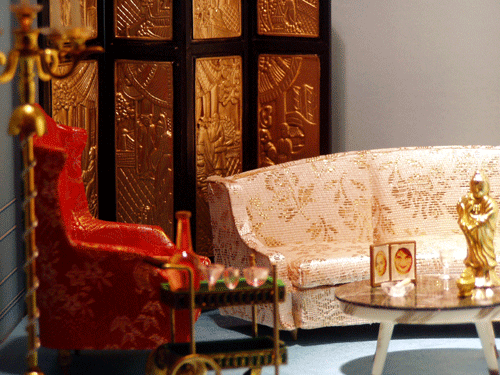
Why collect stuff? When do you give in to the impulse to collect?
Collecting Barbies took me by surprise. I started collecting in the early ’90s after I’d moved from Los Angeles to New York. I was in a relationship; my partner and I collected some art, some vintage household items, even things such as Christmas tree ornaments and refrigerator magnets. We went around to flea markets and antique shows, which is where I first saw vintage Barbie pieces. The passion for collecting, though, came out of a kind of midlife crisis, a way of trying to reconcile certain conflicts, such as some friendships that ended badly, or my disappointment with the competitiveness of the New York poetry scene. I’ve written about, and spent a lot of hours in therapy talking about, this. Collecting was a way of taking refuge, of soothing those wounds. Collecting Barbie wasn’t something I consciously decided to do; it came upon me. Discovering that you could locate and own vintage Barbie items was a revelation, and very exciting. I didn’t know that stuff still existed; I thought it had all disappeared.
How will you know when you’re finished with your collection, or will you ever be?
You know what they say: a complete collection is a dead collection. When you get it all, it’s over. So much of collecting is about the quest and the acquiring, the step-by-step accumulation. The process is, in many ways, more interesting than the actual objects. It’s not unlike writing poems. You wait for, want the next one and then it comes, you write it and then it’s on to waiting for, wanting the next. I’m now at a different place in my collecting. At first it was like smoking. I’d get something, and okay, that was good, but then I’d want the next thing. Smoking, too, is never satisfying, or only temporarily satisfying. I had such yearning and desire for this stuff. And it’s very expensive, so I couldn’t afford to buy as much as I wanted. I reached a point where I realized I had bought all the stuff that my sisters had owned, what I originally coveted. I mark that as a turning point. After that, I felt less urgency. Now I don’t feel the anxiety that I used to; I’m just collecting at a pace that I’m comfortable with.
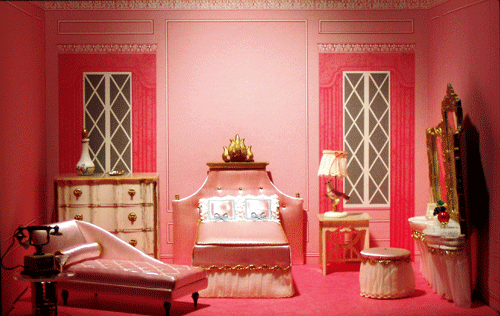
Poems are documents. Collections are documents. What does your collection document that your poetry doesn’t?
Some of my collage poems, into which I work ephemera, are related to my collecting. Documentation, though, takes place only in the poems. What does a collection really document, other than the collector’s obsession, which is often oblique to other people? The objects, in a way, are kind of meaningless. A collector has an emotional attachment to the objects, but it’s about one’s relationship to the objects, not the objects themselves.
Do your friends and family understand your obsession?
The people in my life have been terrific and supportive, and nonjudgmental. I’m the one who has struggled, struggled with self-judgment and fear of judgment. My mother is no longer living, but I remember sending her pictures of my display cases, and she seemed to take great pleasure in them. It brought back nice memories for her. I don’t think my father knows about my collection. I’ve sometimes wondered why I didn’t, as a child—I must have been seven or eight when I first encountered Barbie—why I didn’t save up my pennies and buy myself a Barbie. The only answer I come up with is that it was just too loaded, that it felt too dangerous, too shameful. I remember the Barbie section at my local drugstore, how I’d just walk by it, I couldn’t stop and look because someone might see me looking, and I wasn’t supposed to like this stuff. And how painful that was. It’s something that puzzles me still. Why didn’t I just do it? I’ve been very brave in other areas of my life. But I was a child; I felt powerless.
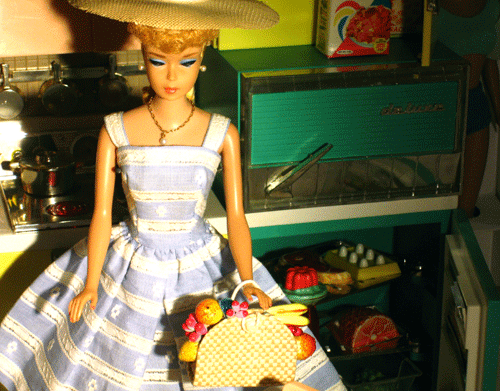
Is there a line you won’t cross, or have crossed—like going into debt or building an addition to your house—when it comes to collecting?
I don’t think I’ve crossed any dangerous lines in my collecting. I’ve been in debt a little, here and there, but it’s all been manageable. As I said, I would like more room, but I won’t move just to have an extra room to put my toys in. So no. For all my ambivalence about it, I think it’s been fun and enriching, and deeply satisfying. Otherwise I wouldn’t do it. Also, and I feel this way about all material possessions, they’re just on loan. I don’t feel like we truly possess anything. I’ve always had that attitude about it.
Is there anything you’d like to tell me about your collection that I didn’t ask?
I guess it would be that you develop memories about the things you collect. You have a relationship with these things: where you bought them, who you bought them from, what you were going through in your life when you bought them. I’ve sold a bunch of items that had unpleasant associations for me. It was easy to let go of them, such as a doll I bought the day my mother died; I knew I wouldn’t keep it long, it had an aura of death about it. Also, before eBay, you had to contend with the Barbie dealers, who were part of this whole Barbie world. The dealers tried to control everything. They were like drug dealers: you get your fix from them. Most of them were unpleasant. I could tell you lots of war stories from those years. Then eBay came along, so I don’t have to rely on dealers anymore. I bought something today, as a matter of fact. A Skipper outfit, never removed from box. It’s called “Dress Coat.” It’s a red velvet coat with a hat, a little purse, shoes, and gloves. Only $61—a steal. These days, to find something, all you need to do is go online; it’s there whenever you want it. I find that empowering. Being able to buy this stuff as an adult, without shame—well, that’s empowering too.
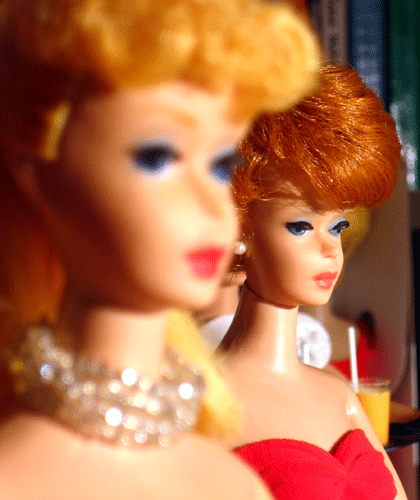
Photos by Nick Twemlow.
Richard Siken: What do you collect?
David Trinidad: My whole adult life I’ve collected books and movies—I’m a sort of a DVD addict. I don’t think of those, though, as real collections. For certain authors I love, I’ll buy different editions of the same books—not to read, but as objects. In that regard I think of book collecting as real collecting. But I have more formal collections. The biggest ones are vintage Barbies and Yardley makeup from the ’60s. Yardley made a line of makeup for teenage girls that was very Mod—their lip gloss was called Slicker and their eye shadow was called Glimmerick, and the packaging had lots of colorful stripes and curlicues. I also have some minor collections: comic books; troll dolls; a line of dollhouse furniture, also from the ’60s, called Petite Princess; board games; Liddle Kiddles, which were these small dolls produced by Mattel; toy theaters; and movie memorabilia, particularly Valley of the Dolls.

Why Barbie?
It was something that I wanted as a child and couldn’t have. The times and my father forbade it. I have two younger sisters, and they had a pretty abundant Barbie collection. I was a boy and wasn’t supposed to be interested in such things. I was supposed to like war, cowboys, Indians, and Erector sets. I’ve written poems about all this. One’s called, simply enough, “Playing with Dolls.” It’s about sneaking downstairs to look at my sisters’ dolls and how forbidden that was. I’m attached to the dolls and clothing of that period—roughly, between 1959 and 1966. The clothes are important, if not more important, than the dolls. I really like to collect outfits in their original packaging—“never removed from box” or “NRFB,” as they say in collecting circles. It’s a way of possessing the items in the condition they would have been in if I’d been able to purchase them myself at the time. I’m not interested in the garish Barbies they make nowadays.

Why Barbie and not Ken?
I collect Ken too. There’s a whole line of characters—friends and relatives of Barbie—that Mattel produced. There’s Ken, Barbie’s boyfriend, and Midge, her best friend, and Skipper, her little sister, and Ken’s friend Allan, and Scooter, who was Skipper’s friend, and Francie, Barbie’s Mod cousin. A whole little universe.

How do you display your collections?
I haven’t displayed them in many years. At the moment, they’re in the closet. In New York, I displayed them in several display cases along a wall, which I dismantled a long time ago. At one point, I thought I was done with collecting and sold off a chunk of my collection. Then after 9/11 and moving from New York to Chicago, I started buying again. Lately I’ve been thinking I might want to display them, but I don’t have the space. This stuff is not supposed to be exposed to direct sunlight, which degrades and fades it. Having a separate room with blacked-out windows would be ideal. I dream of having a separate toy or collection room, a kind of Fortress of Solitude, but have yet to realize that.

What’s the most important item in your collections?
It isn’t a Barbie product; it isn’t any of the mass-produced things. Those you can sell and buy back later if you want. I have an edition of All My Pretty Ones, which is my favorite Anne Sexton book, signed by her. I have an original Travilla sketch for one of the costumes in Valley of the Dolls. I have three little dresses that my mother made for my sisters’ Barbies. These personalized, one-of-a-kind things are more meaningful to me than the mass-produced items.

Why collect stuff? When do you give in to the impulse to collect?
Collecting Barbies took me by surprise. I started collecting in the early ’90s after I’d moved from Los Angeles to New York. I was in a relationship; my partner and I collected some art, some vintage household items, even things such as Christmas tree ornaments and refrigerator magnets. We went around to flea markets and antique shows, which is where I first saw vintage Barbie pieces. The passion for collecting, though, came out of a kind of midlife crisis, a way of trying to reconcile certain conflicts, such as some friendships that ended badly, or my disappointment with the competitiveness of the New York poetry scene. I’ve written about, and spent a lot of hours in therapy talking about, this. Collecting was a way of taking refuge, of soothing those wounds. Collecting Barbie wasn’t something I consciously decided to do; it came upon me. Discovering that you could locate and own vintage Barbie items was a revelation, and very exciting. I didn’t know that stuff still existed; I thought it had all disappeared.
How will you know when you’re finished with your collection, or will you ever be?
You know what they say: a complete collection is a dead collection. When you get it all, it’s over. So much of collecting is about the quest and the acquiring, the step-by-step accumulation. The process is, in many ways, more interesting than the actual objects. It’s not unlike writing poems. You wait for, want the next one and then it comes, you write it and then it’s on to waiting for, wanting the next. I’m now at a different place in my collecting. At first it was like smoking. I’d get something, and okay, that was good, but then I’d want the next thing. Smoking, too, is never satisfying, or only temporarily satisfying. I had such yearning and desire for this stuff. And it’s very expensive, so I couldn’t afford to buy as much as I wanted. I reached a point where I realized I had bought all the stuff that my sisters had owned, what I originally coveted. I mark that as a turning point. After that, I felt less urgency. Now I don’t feel the anxiety that I used to; I’m just collecting at a pace that I’m comfortable with.

Poems are documents. Collections are documents. What does your collection document that your poetry doesn’t?
Some of my collage poems, into which I work ephemera, are related to my collecting. Documentation, though, takes place only in the poems. What does a collection really document, other than the collector’s obsession, which is often oblique to other people? The objects, in a way, are kind of meaningless. A collector has an emotional attachment to the objects, but it’s about one’s relationship to the objects, not the objects themselves.
Do your friends and family understand your obsession?
The people in my life have been terrific and supportive, and nonjudgmental. I’m the one who has struggled, struggled with self-judgment and fear of judgment. My mother is no longer living, but I remember sending her pictures of my display cases, and she seemed to take great pleasure in them. It brought back nice memories for her. I don’t think my father knows about my collection. I’ve sometimes wondered why I didn’t, as a child—I must have been seven or eight when I first encountered Barbie—why I didn’t save up my pennies and buy myself a Barbie. The only answer I come up with is that it was just too loaded, that it felt too dangerous, too shameful. I remember the Barbie section at my local drugstore, how I’d just walk by it, I couldn’t stop and look because someone might see me looking, and I wasn’t supposed to like this stuff. And how painful that was. It’s something that puzzles me still. Why didn’t I just do it? I’ve been very brave in other areas of my life. But I was a child; I felt powerless.

Is there a line you won’t cross, or have crossed—like going into debt or building an addition to your house—when it comes to collecting?
I don’t think I’ve crossed any dangerous lines in my collecting. I’ve been in debt a little, here and there, but it’s all been manageable. As I said, I would like more room, but I won’t move just to have an extra room to put my toys in. So no. For all my ambivalence about it, I think it’s been fun and enriching, and deeply satisfying. Otherwise I wouldn’t do it. Also, and I feel this way about all material possessions, they’re just on loan. I don’t feel like we truly possess anything. I’ve always had that attitude about it.
Is there anything you’d like to tell me about your collection that I didn’t ask?
I guess it would be that you develop memories about the things you collect. You have a relationship with these things: where you bought them, who you bought them from, what you were going through in your life when you bought them. I’ve sold a bunch of items that had unpleasant associations for me. It was easy to let go of them, such as a doll I bought the day my mother died; I knew I wouldn’t keep it long, it had an aura of death about it. Also, before eBay, you had to contend with the Barbie dealers, who were part of this whole Barbie world. The dealers tried to control everything. They were like drug dealers: you get your fix from them. Most of them were unpleasant. I could tell you lots of war stories from those years. Then eBay came along, so I don’t have to rely on dealers anymore. I bought something today, as a matter of fact. A Skipper outfit, never removed from box. It’s called “Dress Coat.” It’s a red velvet coat with a hat, a little purse, shoes, and gloves. Only $61—a steal. These days, to find something, all you need to do is go online; it’s there whenever you want it. I find that empowering. Being able to buy this stuff as an adult, without shame—well, that’s empowering too.

Photos by Nick Twemlow.
Richard Siken is a poet, painter, and filmmaker. His book Crush (Yale University Press, 2005) won the 2004 Yale Series of Younger Poets prize, a Lambda Literary Award, and a Thom Gunn Award. It was also a finalist for the National Book Critics Circle Award. His other books include War of the Foxes (Copper Canyon Press, 2015). Siken has received a Pushcart Prize, two Lannan residencies, two Arizona…


